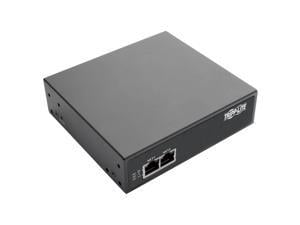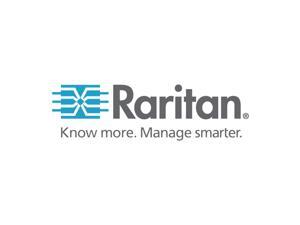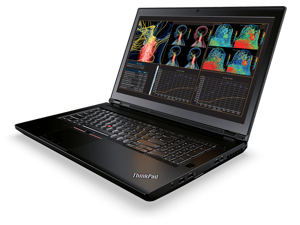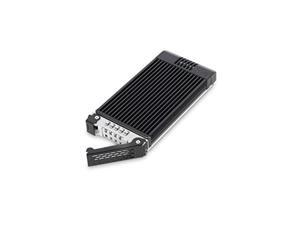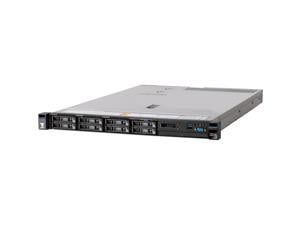Server & Workstation System - Showing 97 - 120 of 11534 Products
Tripp Lite 4-Port Console Server With Dual Gb Nic 4G Flash And 4 Usb Ports
- Model #: B093-004-2E4U
- Item #: 9SIV0F2HZR2228
- Return Policy: TELeasy Return Policy
Lenovo ThinkStation P3 Tiny Workstation Desktop (Intel 20-Core i7-14700, 64GB DDR5 ...
- Type: Business Desktops & Workstations
- Form Factor: Tower
- CPU Name: Intel Core i7-14700
- GPU/VGA Type: NVIDIA T400
- Memory Capacity: 64GB DDR5
- SSD: 2TB NVMe
- Operating System: Windows 11 Pro
- WLAN: 802.11ax Wireless LAN
- Model #: Lenovo ThinkStation P3 i7 T400 64 2
- Item #: 9SIV93XKKC8086
- Return Policy: IST Computers Return Policy
Lenovo ThinkSystem ST650 V3 4U Tower Server - 1x Intel Xeon Silver 4410Y 2 GHz - 32 GB - Intel ...
- # of Processors Installed: 1
- MAX Processors: 2
- Max Memory Capacity: 4TB
- Number of Memory Slots: 32
- Compatible/Certified OS: Windows Server 2019 Windows Server 2022 Red Hat Enterprise Linux 8.6 Red Hat Enterprise Linux 8.7 Red Hat Enterprise Linux 9.0 Red Hat Enterprise Linux 9.1 SUSE Linux Enterprise Server 15 SP4 Ubuntu 22.04 LTS x64
- Dimensions: Height: 18.2" Width: 6.9" Depth: 28.9"
- Weight: 86.20 lb
- Package Contents: ThinkSystem ST650 V3 7D7A1007NA Server Power Cord
- Model #: 7D7A1007NA
- Item #: 9SIV04ZKEJ7674
- Return Policy: IPC Store Return Policy
Raritan Dominion KX III DKX3-816 KVM SwitchBox
- Brand: Raritan
- Type: Tower
- Model #:
- Item #: 9SIV1DSKPM9825
- Return Policy: NothingButSavings Return Policy
Black Box LES1700 Series Console Server POTS Modem Dual 10/100/1000
- Brand: Black Box Innovations
- Type: Tower
- Model #:
- Item #: 9SIV1DSKH23502
- Return Policy: NothingButSavings Return Policy
Lenovo ThinkPad P71 Workstation Laptop - Windows 10 Pro - Xeon E3-1535M, 16GB ECC RAM, ...
- Processor Name: Intel Xeon E3-1535M v6
- Memory: 16GB
- SSD: 4 TB
- GPU/VPU: NVIDIA Quadro P3000
- Brand: Lenovo
- Series: P71
- Part Number: 20HK
- Color: Black
- Model #: 889800997716
- Item #: 9SIV0E48EZ6945
- Return Policy: Deus PC Return Policy
Lenovo ThinkStation P3 Tiny Workstation, Intel 20-Core i7-14700, 16GB DDR5 RAM, 512GB ...
- Type: Desktop PC
- Form Factor: Desktop
- CPU Name: Intel Core i7-14700
- GPU/VGA Type: Intel UHD Graphics
- Memory Capacity: 16GB DDR5
- SSD: 512GB
- Operating System: Windows 11 Pro
- WLAN: 802.11ax Wireless LAN
- Model #: ThinkStation P31142-A_CTO_N1
- Item #: 9SIV70AKMX9708
- Return Policy: PConline365 Return Policy
Lenovo ThinkPad P71 Workstation Windows 10 Pro - Xeon E3-1535M, 64GB ECC RAM, 512GB ...
- Processor Name: Intel Xeon E3-1535M v6
- Memory: 64GB
- SSD: 500 GB
- GPU/VPU: NVIDIA Quadro P4000
- Brand: Lenovo
- Series: P71
- Part Number: 20HK
- Color: Black
- Model #: 889800823299
- Item #: 9SIV0E48F00169
- Return Policy: Deus PC Return Policy
Lenovo ThinkPad P71 Workstation Laptop - Windows 10 Pro - Intel Xeon E3-1505M, 64GB ECC ...
- Processor Name: Intel Xeon E3-1505M v6
- Memory: 64GB
- SSD: 4 TB
- GPU/VPU: NVIDIA Quadro P3000
- Brand: Lenovo
- Series: P71
- Part Number: 20HK
- Color: Black
- Model #: 889800935367
- Item #: 9SIV0E48EP9973
- Return Policy: Deus PC Return Policy
Lenovo ThinkPad P71 Workstation - Windows 10 Pro - Xeon E3-1535M, 64GB ECC RAM, 2TB ...
- Processor Name: Intel Xeon E3-1535M v6
- Memory: 64GB
- SSD: 2 TB
- GPU/VPU: NVIDIA Quadro P3000
- Brand: Lenovo
- Series: P71
- Part Number: 20HK
- Color: Black
- Model #: 889800729287
- Item #: 9SIV0E48EZ8327
- Return Policy: Deus PC Return Policy
Lenovo ThinkPad P71 Workstation - Windows 10 Pro - Intel Xeon E3-1535M, 16GB RAM, 2TB ...
- Processor Name: Intel Xeon E3-1535M v6
- Memory: 16GB
- SSD: 2 TB
- GPU/VPU: NVIDIA Quadro P4000
- Brand: Lenovo
- Series: P71
- Part Number: 20HK
- Color: Black
- Model #: 889800282485
- Item #: 9SIV0E48EP6296
- Return Policy: Deus PC Return Policy
Lenovo ThinkPad P71 Workstation - Windows 10 Pro - Xeon E3-1535M, 32GB RAM, 2TB PCIe ...
- Processor Name: Intel Xeon E3-1535M v6
- Memory: 32GB
- SSD: 2 TB
- GPU/VPU: NVIDIA Quadro P4000
- Brand: Lenovo
- Series: P71
- Part Number: 20HK
- Color: Black
- Model #: 889800521805
- Item #: 9SIV0E48EU1708
- Return Policy: Deus PC Return Policy
Lenovo ThinkPad P71 Workstation - Windows 10 Pro - Xeon E3-1535M, 8GB RAM, 2TB PCIe ...
- Processor Name: Intel Xeon E3-1535M v6
- Memory: 8GB
- SSD: 2 TB
- GPU/VPU: NVIDIA Quadro P4000
- Brand: Lenovo
- Series: P71
- Part Number: 20HK
- Color: Black
- Model #: 889800104183
- Item #: 9SIV0E48EU1471
- Return Policy: Deus PC Return Policy
Lenovo ThinkStation P3 Tiny Workstation, Intel 20-Core i7-14700, 64GB DDR5 RAM, 2TB ...
- Type: Desktop PC
- Form Factor: Desktop
- CPU Name: Intel Core i7-14700
- GPU/VGA Type: Intel UHD Graphics
- Memory Capacity: 64GB DDR5
- SSD: 2TB
- Operating System: Windows 11 Pro
- WLAN: 802.11ax Wireless LAN
- Model #: ThinkStation P31142-D_CTO_N1
- Item #: 9SIV70AKMX9704
- Return Policy: PConline365 Return Policy
ICY DOCK ToughArmor MB601M2K-1B Mobile Rack Drive Tray | MB601TP-1B
- Model #: MB601TP-1B
- Item #: 9SIVAMDKFP0776
- Return Policy: SuperiorQuality Return Policy
Lenovo ThinkPad P71 Workstation - Windows 10 Pro - Xeon E3-1535M, 64GB RAM, 2TB PCIe ...
- Processor Name: Intel Xeon E3-1535M v6
- Memory: 64GB
- SSD: 2 TB
- GPU/VPU: NVIDIA Quadro P3000
- Brand: Lenovo
- Series: P71
- Part Number: 20HK
- Color: Black
- Model #: 889800347603
- Item #: 9SIV0E48ET9774
- Return Policy: Deus PC Return Policy
Lenovo ThinkPad P71 Workstation - Windows 10 Pro - Xeon E3-1535M, 64GB ECC RAM, 2TB ...
- Processor Name: Intel Xeon E3-1535M v6
- Memory: 64GB
- SSD: 2 TB
- GPU/VPU: NVIDIA Quadro P4000
- Brand: Lenovo
- Series: P71
- Part Number: 20HK
- Color: Black
- Model #: 889800129964
- Item #: 9SIV0E48F00238
- Return Policy: Deus PC Return Policy
Lenovo ThinkPad P71 Workstation - Windows 10 Pro - Xeon E3-1535M, 16GB ECC RAM, 2TB ...
- Processor Name: Intel Xeon E3-1535M v6
- Memory: 16GB
- SSD: 2 TB
- GPU/VPU: NVIDIA Quadro P4000
- Brand: Lenovo
- Series: P71
- Part Number: 20HK
- Color: Black
- Model #: 889800019494
- Item #: 9SIV0E48EZ9977
- Return Policy: Deus PC Return Policy
Lenovo System x x3550 M5 8869KGU 1U Rack Server - 1 x Intel Xeon E5-2630 v4 Deca-core (10 ...
- Brand: Lenovo
- Series: x3550 M5
- Type: Rack
- CPU Type: Intel Xeon
- CPU Speed: E5-2630 v4 (2.20 GHz)
- Number of CPU Cores: 10-Core Processor
- MAX Processors: 1
- Installed Memory Size: 16GB
- Model #: 8869KGU
- Item #: 9SIV0E466T9950
- Return Policy: Deus PC Return Policy
Lenovo ThinkPad P71 Workstation Laptop - Windows 10 Pro - Intel Xeon E3-1535M, 64GB ECC ...
- Processor Name: Intel Xeon E3-1535M v6
- Memory: 64GB
- SSD: 2 TB
- GPU/VPU: NVIDIA Quadro P4000
- Brand: Lenovo
- Series: P71
- Part Number: 20HK
- Color: Black
- Model #: 889800377181
- Item #: 9SIV0E48ER7204
- Return Policy: Deus PC Return Policy
Lenovo ThinkPad P71 Workstation - Windows 10 Pro - Intel Xeon E3-1535M, 64GB ECC RAM, ...
- Processor Name: Intel Xeon E3-1535M v6
- Memory: 64GB
- SSD: 1 TB
- GPU/VPU: NVIDIA Quadro P4000
- Brand: Lenovo
- Series: P71
- Part Number: 20HK
- Color: Black
- Model #: 889800041723
- Item #: 9SIV0E48ER8505
- Return Policy: Deus PC Return Policy
Lenovo ThinkPad P71 Workstation - Windows 10 Pro, Xeon E3-1535M, 64GB ECC RAM, 500GB ...
- Processor Name: Intel Xeon E3-1535M v6
- Memory: 64GB
- SSD: 500 GB
- GPU/VPU: NVIDIA Quadro P4000
- Brand: Lenovo
- Series: P71
- Part Number: 20HK
- Color: Black
- Model #: 889800369339
- Item #: 9SIV0E48EZ9784
- Return Policy: Deus PC Return Policy
ICY DOCK ToughArmor MB601VK-1B Mobile Rack Drive Tray | MB601TP-B
- Model #: MB601TP-B
- Item #: 9SIVAMDKFP0778
- Return Policy: SuperiorQuality Return Policy
Lenovo ThinkPad P71 Workstation - Windows 10 Pro - Intel Xeon E3-1535M, 64GB RAM, 2TB ...
- Processor Name: Intel Xeon E3-1535M v6
- Memory: 64GB
- SSD: 2 TB
- GPU/VPU: NVIDIA Quadro P3000
- Brand: Lenovo
- Series: P71
- Part Number: 20HK
- Color: Black
- Model #: 889800373572
- Item #: 9SIV0E48EP3771
- Return Policy: Deus PC Return Policy
Choosing the Right Server System
Introduction
If your organization has several computers and will continue to increase that number, you should consider purchasing server and workstation systems. They are computer systems that function as centralized resources for a network. Before shopping for a server though, there are a few basics that you need to know.
What is a Server?
A server is a computer that provides services or data to other computers, known as clients. In most network configurations, the server is the main gateway between an organization’s internal network and the internet. It can be used for a variety of purposes, from storing files to hosting Web sites. The hardware inside server and workstation systems is similar to what you would find in a desktop computer. They have the usual components such as processors, memory, and hard drives. The difference is that the components inside a server are designed for long and continuous use with little to no downtime.
Do I Need a Server?
If your organization has data that needs to be accessed by multiple users, then it will benefit from utilizing server and workstation systems. Even if a network is comprised of only two computers, a server is excellent for storing and sharing files for those two computers. And if you have mobile staff that frequently travel, they will be able to remotely access information and programs on your organization’s network through the server.
Larger organizations will probably have several servers, each performing different tasks. For example, one server could be for file sharing, one for hosting the Web site, and another for handling the e-mail needs of the staff. For larger organizations with multiple offices, having a server means that the staff will be able to easily share files across different geographic locations.
What Server Should I Get?
There are three types of server and workstation systems, tower, rack-mount, and blade. Which one you should use depends on the size of your organization’s network and the amount of traffic you expect.
Tower
The most basic of the three, a tower server looks very similar to a desktop tower computer. One advantage of a tower server is that it does not require a great deal of space and is ideal for organizations with a small network.
The downsides of a tower system are that it has limited expandability and utilizes a fair amount of cabling. In an office with several tower server systems, this can mean a jumble of cables and a lot of space used up by peripherals and input devices.
Rack-mounted
A rack-mounted server bears little resemblance to a desktop tower. It has standardized dimensions and is designed to be inserted into a rack-mount server chassis. A rack-mount chassis can hold several servers in slots, one on top of another. A rack-mount setup is much more space-efficient than a tower and it is possible to put many more servers into one space than with tower server systems. Aside from the space savings, rack-mount servers also makes cabling more manageable.
Blade
A blade server is similar to a rack-mounted workstation computer in that it also needs to be installed into an enclosure. However, a blade computer server is much more compact and space-efficient than a rack-mount, because the internal components are designed to have a low profile or be integrated onto the motherboard.








